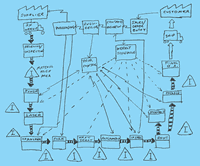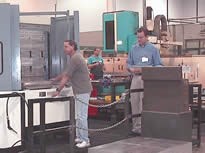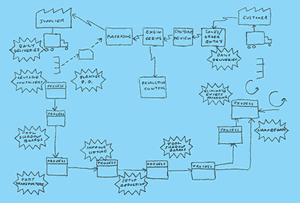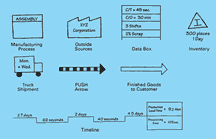Picture-Perfect Manufacturing
The vision of a production process with little or no waste is the inspiration behind lean manufacturing. Value stream mapping is a graphical tool that this contract manufacturer uses to create that vision.
Share





Pictures can lead us to understanding. Consider the dramatic images Michelangelo created on the ceiling of the Sistine Chapel. The climactic events of man's creation, fall and redemption are depicted in bold shapes and vivid colors. These scenes do more than tell a story. They show us how good and evil vie for the living soul and how grace ultimately prevails over sin.
We can use pictures to help us understand what should happen on the factory floor, too. Of course, these pictures will look nothing like an artist's masterpiece, yet the comparison is not as farfetched as it may seem.
Manufacturing is the uniquely human effort to impose a functional design on raw materials, to create value by transforming featureless shapes into objects ultimately intended to meet some need or want. Just as Michelangelo was preoccupied with the moral struggles underlying human experience, manufacturers contend with the never-ending challenge to make manufacturing processes more efficient and profitable. This means finding and eliminating waste. Waste is the devil in disguise on the shop floor.
One technique that uses pictures to help manufacturers find and eliminate waste is value stream mapping. It is a graphical way to analyze where value is—or isn't—being added as material flows through the production process. Using a set of icons and symbols, the analyst depicts what happens at each step of the process, tracing the path that material and information must follow for finished products to reach the customer. By capturing and representing details about every activity, the resulting diagram makes it clear where production leadtime is out of synch with processing time. This picture would show, for example, why a part that is worked on for only 1 hour still needs 10 days to travel through the shop.
By drawing a new picture that shows how workstations and activities can be rearranged to avoid overproduction, excess inventory, unnecessary handling and pointless waiting, planners can envision a path by which customer orders can be filled in less time with less inventory and fewer workers.
Moving in this direction is the essence of lean manufacturing. Value stream mapping gives the manufacturer a "grand vision" into which waste reduction, continuous improvement and other lean techniques must fit. Without this vision, a company may end up with numerous isolated fixes that don't add up to significant savings extending to the bottom line or providing benefits to impress and gratify customers. Value stream mapping organizes the lean manufacturing experience and gives it meaning. This is the art behind waste-free production processes.
Stremel Manufacturing (Minneapolis, Minnesota) is a company that has been using value stream mapping for a number of years now. Stremel is a contract manufacturer of sheet metal fabrications, precision machined components and assemblies, with a long history of service to aerospace, defense and commercial customers. Some of its work represents long-term contracts, while other work, primarily in CNC machining, consists of short-run jobs. Although no one company can illustrate all that value stream mapping is or can do, Stremel's experiences provide more than a glimpse of the technique's usefulness and flexibility, especially in a classic contract manufacturing setting.
Seeing How It Is
"We started our journey to lean manufacturing in 1999," recalls Darin Andries, business development manager at Stremel. At the time, the company was encouraged to participate in several lean manufacturing workshops sponsored by one of its large corporate customers. "One of the first things we learned was that value stream mapping gave us a customized blueprint for becoming a lean manufacturing enterprise. It helped us see where we were, where we needed to go and how to get there in an orderly fashion," Mr. Andries says. He and other managers worked with lean manufacturing consultants from TechSolve (Cincinnati, Ohio) to hone their lean manufacturing skills.
Mr. Andries would laugh if you described him as Stremel's own Michelangelo, but he has become one of the chief value stream mapping artists at the company. Figures 1 and 3 show value stream maps that represent one of the first applications at Stremel. Because this production process involved a product protected by confidentiality agreements with the customer, Mr. Andries created simplified "generic" value stream maps based on the real ones to illustrate some basic concepts about value stream mapping.
Figure 1 is the current state map. It shows how the shop originally fabricated a sheet metal component. Some of the main processes on the map are welding, assembly and painting. These are represented by standard mapping icons such as process blocks, data boxes and inventory triangles. The icons and symbols follow the conventions established by Mike Rother and John Shook in their book, "Learning to See," published by the Lean Enterprise Institute (Brookline, Massachusetts, www.lean.org). This book did much to popularize the technique of value stream mapping in the United States, but the concepts were largely derived from the authors' experiences with the Toyota production system.
"Preparing the current state map for this process was an eye-opener," says Mr. Andries. "It gave us objective yet qualitative facts about how we were making the parts." Preparing the map involved several walk-throughs on the shop floor to collect data about the process. One of the most important lessons Stremel learned during these early days was the importance of picturing the flow of information. "We needed to know how material flowed, but we also needed to know how processes found out what to make next," Mr. Andries recalls. "Making you see both material and information flows is one of the chief ways value steam mapping leads to fundamental insights."
A value stream map also helps a company draw a "timeline" that compares production leadtimes to processing times. A sample timeline is shown in Figure 2. The timeline summarizes how much time a process devotes to actual part making. A discrepancy indicates that excessive waiting time and excessive inventory are draining profit and tying up capital in the form of work in process (WIP).
Seeing How It Should Be
Figure 3 represents one of the future state maps developed by Mr. Andries and his team, based on suggestions solicited during a brainstorming session with operators and supervisors involved with this fabricating line.
"The future state map is really what value stream mapping is all about," says Mr. Andries. "Creating a future state map is an exercise that forces us to identify what our customers really want and then helps us use that expectation as the guiding principle behind our plans for process improvements."
Because the future state map keeps the focus on meeting customer requirements, the map helps a shop concentrate on waste-reduction initiatives that improve the overall flow rather than merely optimize individual processing steps. As Mr. Andries explains, "The future state map isn't just a plan. It's a strategy. It helps us make decisions about what to fix first and to verify that the fix is really giving us the results we are looking for."
For example, the future state map developed for the fabricating line moved certain processes together to create "continuous flow." At these points, workpieces would be produced one at a time and passed immediately to the next step. This eliminated batching the workpieces and the waiting time between the steps. The company also established standard batch sizes for the remaining unconnected process steps. This change prevented both overproduction at certain steps and shortages of incoming parts at other processes, creating a more level production mix. This also allowed a visual "pull" system to be created at critical points. Wooden racks designed to hold one batch of fabrications would be set up between processes so that operators could see how many pieces needed to be produced to maintain a more consistent flow to downstream processes.
The future state map reduced processing steps from 15 to nine. "When implemented, we could see that WIP inventory could be drastically reduced," says Mr. Andries. "The projected savings proved that a planned relocation of the welding department to facilitate work flow would pay for itself in months." (According to Mr. Andries, the value of inventory was reduced by 45 percent after implementing the plan.) This kind of objective, numbers-based decision-making was a far cry from the "gut feel" approach the shop often had to take when making such decisions in the past.
Of course, a future state map becomes a current state map as soon as changes and improvements are made. "You go back and make a new future state map," Mr. Andries says. "That's one of the beauties of value stream mapping. Ultimately, it puts your whole organization on a future-becomes-present cycle that keeps customer satisfaction in the forefront."
The Value Stream Mindset
"Value stream mapping made us conscious of the concepts and principles of lean manufacturing," Mr. Andries continues. "Value stream mapping helped us to start thinking lean as a habit."
This "value stream mindset" has been especially beneficial for Stremel's short-run contract work. Mr. Andries explains: "For one thing, we created a set of generic value streams that emphasize opportunities for continuous flow rather than batching. So we estimate and quote jobs with savings from lean manufacturing built in."
A more specific and formal application of value stream mapping is then undertaken to fine-tune the process plan when the contract is awarded. "We create a process plan, then scrutinize it as if it were a current state map of an existing process. Next we develop a future state map to tweak the process and make it leaner," Mr. Andries says.
For example, one of the key concepts in value stream mapping is takt time. Takt time indicates how often a total process must produce a finished part in the work time available to meet customer demand. Ideally, the cycle time of the downstream process nearest to customer delivery should be close to takt time. This process (often referred to as the "pacemaker") sets the pace for upstream processes from which the pacemaker process pulls work.
"Takt time helps us determine if a process will be effective or not," Mr. Andries says. "We can look at the process plan for a part and make sound decisions about which machine to use, how much change-over time is acceptable and how many change-overs to allow."
According to Mr. Andries, the value stream mindset guards against a high-production mentality—the conventional thinking that making as many parts as possible in the least amount of time with the fewest change-overs is always the most cost-effective way to make a part. In fact, thinking about the value stream may reveal that a smaller, slower, less-expensive-to-operate machine will be more than adequate. Meanwhile, as order quantities increase, a different future state can be visualized for changing the production strategy to keep up.
The value stream mindset may also encourage planners at Stremel to look for opportunities that integrate operations other than CNC machining. For example, by bringing assembly, inspection, marking or finishing operations in house, the company offers the customer additional value while taking advantage of continuous flow to create shared savings. Likewise, the value stream mindset can help focus on how suppliers can contribute to waste reduction. For example, Stremel routinely looks for ways a supplier can deliver material directly to a workstation. When the company added a 40,000-square-foot facility for its expanded CNC machining operations in 2003, designated areas were laid out at each machine for incoming and finished outgoing workpieces, allowing pallets loaded in a preset manner by the supplier to be dropped off at the machine.
Managing capital investments also benefits from the prevailing value stream mindset. "A pending contract put us in a rush to install a large horizontal machine—until we looked at how we could stream the parts across existing equipment more effectively," says Mr. Andries. "We found we didn't need the HMC right away."
Finally, Mr. Andries points out that a value stream mindset does not require that full-blown current and future state maps be drawn up. He often uses a spreadsheet application on his laptop computer for mapping simple lists of process steps and the corresponding timeline of lead and process times. "The value stream map is not an end in itself. It's just one of many tools in the ‘lean toolbox' for finding waste before it gets built into a process," he says.
Never Stop Looking
No one at Stremel Manufacturing would claim that this company is already a showcase of picture-perfect manufacturing. Everyone understands that lean manufacturing is an endless effort to take waste out of each production process. Yet the company has been on the journey to lean long enough that forward motion is self-sustaining. Value stream mapping literally charts the right path to follow and keeps the company on course.
Read Next
Building Out a Foundation for Student Machinists
Autodesk and Haas have teamed up to produce an introductory course for students that covers the basics of CAD, CAM and CNC while providing them with a portfolio part.
Read MoreSetting Up the Building Blocks for a Digital Factory
Woodward Inc. spent over a year developing an API to connect machines to its digital factory. Caron Engineering’s MiConnect has cut most of this process while also granting the shop greater access to machine information.
Read MoreRegistration Now Open for the Precision Machining Technology Show (PMTS) 2025
The precision machining industry’s premier event returns to Cleveland, OH, April 1-3.
Read More































.jpg;maxWidth=970;quality=90)